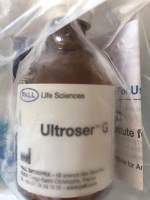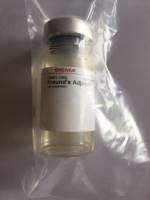
Fibronectin纤维连接蛋白红色标记,Fibronectin (Red fluorescent, rhodamine)
价格: ¥5250
产品详情
文献和实验
相关推荐
英文名 :Fibronectin (Red fluorescent, rhodamine)
CAS号 :FNR01-A
保存条件 :cytoskeleton
供应商 :上海研卉生物
库存 :Fibronectin红色标记
规格 :5X20UG
Fibronectin红色标记,Fibronectin (Red fluorescent, rhodamine) /5X20UG货号FNR01-A
| Product | Cat. # | |
| Fibronectin (Red fluorescent, rhodamine) |
FNR01 | |
| Fibronectin |
FNR02 | |
| Fibronectin (Biotinylated) |
FNR03 | |
| Laminin (Red fluorescent, rhodamine) |
LMN01 | |
| Laminin (Green fluorescent, HiLyte488TM) |
LMN02 | |
| Laminin (Biotinylated) |
LMN03 |
在正常细胞功能中的作用
细胞外基质(ECM)的形成需要细胞分泌ECM蛋白。组装是通过遵循严格的分层组装模式来实现的,这种组装模式从纤维连接蛋白丝在细胞表面的沉积开始,这一过程被称为纤维生成(1)。细胞通过降解和重组机制继续重塑ECM,ECM的动态性质在发育、伤口愈合和某些疾病状态期间尤其明显(见下文)(2)。据估计,包含哺乳动物ECM或“核心基质体”的蛋白质超过300种,其中不包括大量ECM相关蛋白质(3)。细胞通过整合素和syndecans等受体与ECM相互作用,从而产生多种信号转导,以调节关键的细胞过程,如细胞的分化、增殖、存活和运动(3)。ECM还被证明能结合生长因子,如VEGF、HGF和BMP,这些生长因子被认为能产生生长因子梯度,从而在发育过程中调节模式的形成(4)。许多ECM调节的细胞过程是通过肌动蛋白和微管细胞骨架的重组进行的(5)。
Role in disease
Aberrant regulation or genetic defects of the ECM components often results in a pathogenic state.
Genetic diseases: Several diseases have been shown to be caused by mutations in ECM genes, including macular degenerative disease (Fibulin 3, ref. 6), osteoarthritis (Asporin, ref. 7) and congenital muscular dystrophy (Laminins, ref. 8).
Cancer and Metastasis: There are many examples demonstrating that altered expression of a given ECM protein is correlated with cancer (9). It is also well established that degradation of the ECM, via the actions of matrix metalloproteinases, is a prerequisite to metastatic invasion of cancer cells (10).
Atherosclerosis: This disease has been linked to a buildup of collagen plaques (11).
Biomedical Applications
The field of regenerative medicine and tissue engineering is utilizing ECM components to try to generate a predictable formation of tissues and organs from a given cell type (12,13).
Assays Used to study ECM
There is a preponderance of commercially available ECM reagents and cell attachment/invasion assays. The best known of the ECM reagents is MatrigelTM from BD which is an ECM extract from the Engelbreth-Holm-Swarm mouse tumor. MatrigelTM is composed of laminin (56%), collagen type IV (31%), and enactin (8%), and several growth factors, including EGF (0.7 ng/ml), PDGF (12 ng/ml), IGF-1 (16ng/ml), and TGF-a (2.3 ng/ml) (14). Similar products include ECMatrixTM (Millipore) and ECM gel (Sigma). Most commercially available invasion assays utilize a Boyden-chamber like system (15).
Cytoskeleton offers a unique line of fluorescently-labeled and biotinylated fibronectins and laminins. Several applications of these products are listed below.
Application #1: In vitro invadopodia/podosome invasion assay (Cat.# FNR01, FNR02, LMN01, LMN02)
Cytoskeleton’s fluorescently-labeled fibronectins and laminins can be used in an in vitro invadopodia/podosome invasion assay (16). This assay allows a high resolution examination of local cell invasion on specific ECM components and can be used to assess the invasive potential of cells and to examine compounds/pathways that affect this stage of invasion. Originally described by Artym et al. for gelatin, the assay is equally applicable to fluorescent fibronectin or laminin (16).
Application #2: Signaling Pathways Involved in Fibronectin Matrix Assembly: Fibrillogenesis (Cat.# FNR01, FNR02, FNR03)
Unlike other ECM components that can self-polymerize under physiological conditions, fibronectin matrix assembly is a cell-dependent process. Understanding the mechanisms involved in FN assembly and how these interplay with cellular, fibrotic, and immune responses may reveal targets for the future development of therapies to regulate aberrant tissue-repair processes. Also, tissue engineering strongly depends on the ability to control the rate and pattern of ECM formation. Cytoskeleton’s labeled fibronectins can be used to monitor fibrillogenesis;
Fluorescent Fibronectin Substrates (FNR01 & FNR02)
This method involves fluorescent tracing of fibril formation through incorporation of fluorescent fibronectins (17).
The conversion of soluble fibronectin to insoluble fibrils on the cell surface can be visualized by feeding cell culture with media containing either TRITC-labeled fibronectin (Cat.# FNR01) or HiLyte488-labeled fibronectin (Cat.# FNR02). The level of incorporated fibronectin can be observed and quantitated by fluorescence microscopy (18).
Biotinylated Fibronectin Substrate (FNR03)
This method incorporates biotinylated fibronectin into the cells of interest and quantitates detergent soluble (cell bound) and detergent insoluble (fibrils) fibronectin. This assay has been used successfully to examine the role of Rho proteins in fibrillogenesis (19).
Application #3: Tissue Engineering Applications (FNR03 & LMN03)
It has been shown that biotinylated ECM proteins can adopt a more native conformation when bound to a streptavidin surface and that this can lead to enhanced cellular binding to the ECM (20).
References
- Sottile J. and Hocking D. 2002. Fibronectin polymerization regulates the composition and stability of extracellular matrix fibrils and cell-matrix adhesions. Mol. Biol. Cell. 13, 3546-3559.
- Daley W. et al. 2007. Extracellular matrix dynamics in development and regenerative medicine. J. Cell Sci. 121, 255-264.
- Hynes R. and Naba. 2011. Overview of the matrisome-an inventory of extracellular matrix constituents and functions. Cold Spring Harb Perspect Biol. doi:10.1101.
- Taipale J. and Keski-Oja J. 1997. Growth factors in the extracellular matrix. FASEB J. 11, 51-59.
- Ballestrem C. et al. 2004. Interplay between the actin cytoskeleton, focal adhesions and microtubules. Cell Motility. Ed Anne Ridley, Michelle Peckham and Peter Clark. 75-99.
- Klenotic PA. et al. 2004. Tissue inhibitor of metalloproteinases-3 (TIMP-3) is a binding partner of epidermal growth factor-containing fibulin-like extracellular matrix protein 1 (EFEMO1). Implications for macular degeneration. J. Biol. Chem. 279, 30469-30473.
- Kizawa H. et al. 2005. An aspartic acid repeat polymorphism in aspirin inhibits chondrogenesis and increases susceptibility to osteoarthritis. Nat. Genet. 37, 138-144.
- Hall TE. et al. 2007. The zebrafish candyfloss mutant implicates extracellular matrix adhesion failure in laminin alpha-2-deficient congenital muscular dystrophy. Proc. Natl. Acad. Sci. USA. 104, 7092-7097.
- Hu J. et al. 2008. Matrix metalloproteinase inhibitors as therapy for inflammatory and vascular disease. Nat. Rev. Drug Discov. 6, 480-498.
- Pupa S. et al. 2002. New insights into the role of extracellular matrix during tumor onset and progression. J. Cell Physiol. 192, 259-267.
- Seyama Y. and Wachi H. 2004. Artherosclerosis and matrix dystrophy. J. Artheroscer. Thromb. 11, 236-245.
- Causa F. et al. 2007. A multi-functional scaffold for tissue regeneration: the need to engineer a tissue analog. Biomaterials. 28, 5093-5099.
- Barker TH. 2011. The role of ECM proteins and protein fragments in guiding cell behavior in regenerative medicine. Biomaterials. 32, 4211-4214.
- Kleinman HK. Et al. 1982. Isolation and characterization of type IV procollagen, laminin and heparin sulfate proteoglycan from EHS sarcoma. Biochemistry. 21, 6188-6193.
- Yuan K. et al. 2006. In vitro matrices for studying tumor cell invasion. Cell Motility in Cancer Invasion and Metastasis Ed. A. Wells. 25-54.
- Artym V. et al. 2009. ECM degradation assays for analyzing local cell invasion. Meth. Mol. Biol., Extracellular Matrix Protocols. 522, 211-219.
- Pankov R. and Momchilova A. 2009. Fluorescent labeling techniques for investigation of fibronectin fibrillogenesis (labeling fibronectin fibrillogenesis). Methods Mol. Biol., Extracellular Matrix Protocols. 522, 261-274.
- Pankov R. et al. 2000. Integrin dynamics and matrix assembly: tensin-dependent translocation of alpha (5)beta(1) integrins promotes early fibronectin fibrillogenesis. J. Cell Biol. 148, 1075-1090.
- Pankov R. and Yamada K. 2004. Non-radioactive quantification of fibronectin matrix assembly. Curr. Protoc. Cell Biol. 10.13.1-10.13.9.
- Lehnert M, et al. 2011. Adsorption and conformation behavior of biotinylated fibronectin on streptavidin-modified TiO(X) surfaces studied by SPR and AFM. Langmuir. 27, 7743-7751.

上海研卉生物科技有限公司
实名认证
金牌会员
入驻年限:10年






